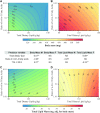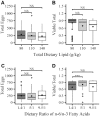Both Dietary Ratio of n-6 to n-3 Fatty Acids and Total Dietary Lipid Are Positively Associated with Adiposity and Reproductive Health in Zebrafish
- PMID: 32258992
- PMCID: PMC7108797
- DOI: 10.1093/cdn/nzaa034
Both Dietary Ratio of n-6 to n-3 Fatty Acids and Total Dietary Lipid Are Positively Associated with Adiposity and Reproductive Health in Zebrafish
Abstract
Background: Controversial findings have been reported in human and animal studies regarding the influence of n-6 (ω-6) to n-3 (ω-3) fatty acid ratios on obesity and health. Two confounding factors may be related to interactions with other dietary lipid components or sex-specific differences in fatty acid metabolism.
Objective: This study investigated main and interactive effects of total dietary lipid, ratio of n-6 to n-3 fatty acids, and sex on growth, adiposity, and reproductive health in wild-type zebrafish.
Methods: Male and female zebrafish (3 wk old) were fed 9 diets consisting of 3 ratios of n-6 to n-3 fatty acids (1.4:1, 5:1, and 9.5:1) varied within 3 total lipid amounts (80, 110, and 140 g/kg) for 16 wk. Data were then collected on growth, body composition (determined by chemical carcass analysis), and female reproductive success (n = 32 breeding events/diet over 4 wk). Main and interactive effects of dietary lipid and sex were evaluated with regression methods. Significant differences within each dietary lipid component were relative to the intercept/reference group (80 g/kg and 1.4:1 ratio).
Results: Dietary lipid and sex interacted in their effects on body weight (P = 0.015), total body length (P = 0.003), and total lipid mass (P = 0.029); thus, these analyses were stratified by sex. Female spawning success decreased as dietary total lipid and fatty acid ratio increased (P = 0.030 and P = 0.026, respectively). While total egg production was not associated with either dietary lipid component, females fed the 5:1 ratio produced higher proportions of viable embryos compared with the 1.4:1 ratio [median (95% CI): 0.915 (0.863, 0.956) vs 0.819 (0.716, 0.876); P < 0.001].
Conclusions: Further characterization of dietary lipid requirements will help define healthy balances of dietary lipid, while the sex-specific responses to dietary lipid identified in this study may partially explain sex disparities in the development of obesity and its comorbidities.
Keywords: body composition; diet-induced obesity; dietary lipid composition; reproductive health; zebrafish.
Copyright © The Author(s) 2020.
Figures


Similar articles
-
The effects of dietary saturated fat source on weight gain and adiposity are influenced by both sex and total dietary lipid intake in zebrafish.PLoS One. 2021 Oct 22;16(10):e0257914. doi: 10.1371/journal.pone.0257914. eCollection 2021. PLoS One. 2021. PMID: 34679092 Free PMC article.
-
Effects of the Dietary ω3:ω6 Fatty Acid Ratio on Body Fat and Inflammation in Zebrafish (Danio rerio).Comp Med. 2015 Aug;65(4):289-94. Comp Med. 2015. PMID: 26310458 Free PMC article.
-
Diets enriched in menhaden fish oil, seal oil, or shark liver oil have distinct effects on the lipid and fatty-acid composition of guinea pig heart.Mol Cell Biochem. 1997 Dec;177(1-2):257-69. doi: 10.1023/a:1006871524271. Mol Cell Biochem. 1997. PMID: 9450671
-
[Simple obesity in children. A study on the role of nutritional factors].Med Wieku Rozwoj. 2006 Jan-Mar;10(1):3-191. Med Wieku Rozwoj. 2006. PMID: 16733288 Review. Polish.
-
An Increase in the Omega-6/Omega-3 Fatty Acid Ratio Increases the Risk for Obesity.Nutrients. 2016 Mar 2;8(3):128. doi: 10.3390/nu8030128. Nutrients. 2016. PMID: 26950145 Free PMC article. Review.
Cited by
-
Nutrient Intake through Childhood and Early Menarche Onset in Girls: Systematic Review and Meta-Analysis.Nutrients. 2020 Aug 22;12(9):2544. doi: 10.3390/nu12092544. Nutrients. 2020. PMID: 32842616 Free PMC article.
-
The effects of intensive feeding on reproductive performance in laboratory zebrafish (Danio rerio).PLoS One. 2022 Nov 29;17(11):e0278302. doi: 10.1371/journal.pone.0278302. eCollection 2022. PLoS One. 2022. PMID: 36445925 Free PMC article.
-
Dietary Fat and Polyunsaturated Fatty Acid Intakes during Childhood Are Prospectively Associated with Puberty Timing Independent of Dietary Protein.Nutrients. 2022 Jan 10;14(2):275. doi: 10.3390/nu14020275. Nutrients. 2022. PMID: 35057456 Free PMC article.
-
Creation of a novel zebrafish model with low DHA status to study the role of maternal nutrition during neurodevelopment.J Lipid Res. 2025 Jan;66(1):100716. doi: 10.1016/j.jlr.2024.100716. Epub 2024 Nov 27. J Lipid Res. 2025. PMID: 39608569 Free PMC article.
-
Common laboratory diets differentially influence zebrafish gut microbiome's successional development and sensitivity to pathogen exposure.Res Sq [Preprint]. 2023 Feb 2:rs.3.rs-2530939. doi: 10.21203/rs.3.rs-2530939/v1. Res Sq. 2023. Update in: Anim Microbiome. 2023 Aug 10;5(1):38. doi: 10.1186/s42523-023-00254-8. PMID: 36778316 Free PMC article. Updated. Preprint.
References
-
- Krishnan S, Cooper JA.. Effect of dietary fatty acid composition on substrate utilization and body weight maintenance in humans. Eur J Nutr. 2014;53(3):691–710. - PubMed
-
- Yang JH, Chang JS, Chen CL, Yeh CL, Chien YW. Effects of different amounts and types of dietary fatty acids on the body weight, fat accumulation, and lipid metabolism in hamsters. Nutrition. 2016;32(5):601–8. - PubMed
-
- Deckelbaum RJ. n-6 and n-3 Fatty acids and atherosclerosis: ratios or amounts?. Arterioscler Thromb Vasc Biol. 2010;30(12):2325–6. - PubMed
-
- Clevenger HC, Kozimor AL, Paton CM, Cooper JA. Acute effect of dietary fatty acid composition on postprandial metabolism in women. Exp Physiol. 2014;99(9):1182–90. - PubMed
Grants and funding
LinkOut - more resources
Full Text Sources

